Related Research Articles

In quantum field theory, the Casimir effect is a physical force acting on the macroscopic boundaries of a confined space which arises from the quantum fluctuations of a field. It is named after the Dutch physicist Hendrik Casimir, who predicted the effect for electromagnetic systems in 1948.

A quantum computer is a computer that takes advantage of quantum mechanical phenomena.
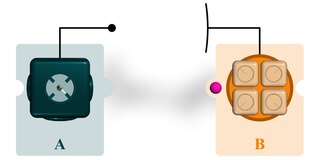
Quantum teleportation is a technique for transferring quantum information from a sender at one location to a receiver some distance away. While teleportation is commonly portrayed in science fiction as a means to transfer physical objects from one location to the next, quantum teleportation only transfers quantum information. The sender does not have to know the particular quantum state being transferred. Moreover, the location of the recipient can be unknown, but to complete the quantum teleportation, classical information needs to be sent from sender to receiver. Because classical information needs to be sent, quantum teleportation cannot occur faster than the speed of light.

Quantum entanglement is the phenomenon of a group of particles being generated, interacting, or sharing spatial proximity in such a way that the quantum state of each particle of the group cannot be described independently of the state of the others, including when the particles are separated by a large distance. The topic of quantum entanglement is at the heart of the disparity between classical and quantum physics: entanglement is a primary feature of quantum mechanics not present in classical mechanics.

Zero-point energy (ZPE) is the lowest possible energy that a quantum mechanical system may have. Unlike in classical mechanics, quantum systems constantly fluctuate in their lowest energy state as described by the Heisenberg uncertainty principle. Therefore, even at absolute zero, atoms and molecules retain some vibrational motion. Apart from atoms and molecules, the empty space of the vacuum also has these properties. According to quantum field theory, the universe can be thought of not as isolated particles but continuous fluctuating fields: matter fields, whose quanta are fermions, and force fields, whose quanta are bosons. All these fields have zero-point energy. These fluctuating zero-point fields lead to a kind of reintroduction of an aether in physics since some systems can detect the existence of this energy. However, this aether cannot be thought of as a physical medium if it is to be Lorentz invariant such that there is no contradiction with Einstein's theory of special relativity.
This is a timeline of quantum computing.
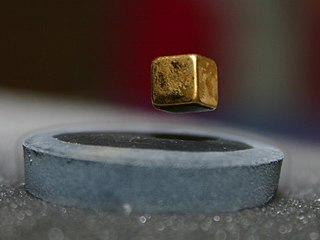
Levitation is the process by which an object is held aloft in a stable position, without mechanical support via any physical contact.
In condensed matter physics, a quasiparticle is a concept used to describe a collective behavior of a group of particles that can be treated as if they were a single particle. Formally, quasiparticles and collective excitations are closely related phenomena that arise when a microscopically complicated system such as a solid behaves as if it contained different weakly interacting particles in vacuum.

In quantum field theory, the quantum vacuum state is the quantum state with the lowest possible energy. Generally, it contains no physical particles. The term zero-point field is sometimes used as a synonym for the vacuum state of a quantized field which is completely individual.
Superconducting quantum computing is a branch of solid state quantum computing that implements superconducting electronic circuits using superconducting qubits as artificial atoms, or quantum dots. For superconducting qubits, the two logic states are the ground state and the excited state, denoted respectively. Research in superconducting quantum computing is conducted by companies such as Google, IBM, IMEC, BBN Technologies, Rigetti, and Intel. Many recently developed QPUs use superconducting architecture.
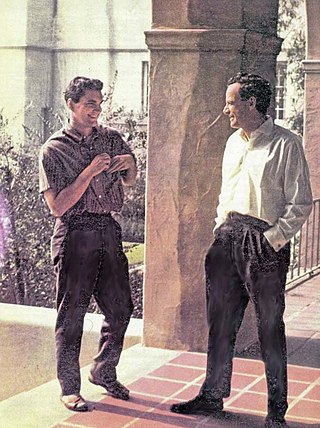
George Frederick Chapline Jr. is an American theoretical physicist, based at the Lawrence Livermore National Laboratory. His most recent interests have mainly been in quantum information theory, condensed matter, and quantum gravity. In 2003 he received the Computing Anticipatory Systems award for a new interpretation of quantum mechanics based on the similarity of quantum mechanics and Helmholtz machines. He was awarded the E. O. Lawrence Award in 1982 by the United States Department of Energy for leading the team that first demonstrated a working X-ray laser.

A Majorana fermion, also referred to as a Majorana particle, is a fermion that is its own antiparticle. They were hypothesised by Ettore Majorana in 1937. The term is sometimes used in opposition to a Dirac fermion, which describes fermions that are not their own antiparticles.
PVLAS aims to carry out a test of quantum electrodynamics and possibly detect dark matter at the Department of Physics and National Institute of Nuclear Physics in Ferrara, Italy. It searches for vacuum polarization causing nonlinear optical behavior in magnetic fields. Experiments began in 2001 at the INFN Laboratory in Legnaro and continue today with new equipment.
Teleportation is a fictional transfer of matter or energy from one point to another without traversing the physical space between them. It is a common subject in science fiction literature and in other popular culture. Teleportation is often paired with time travel, being that the travelling between the two points takes an unknown period of time, sometimes being immediate. An apport is a similar phenomenon featured in parapsychology and spiritualism.

In cosmology, the cosmological constant problem or vacuum catastrophe is the substantial disagreement between the observed values of vacuum energy density and the much larger theoretical value of zero-point energy suggested by quantum field theory.
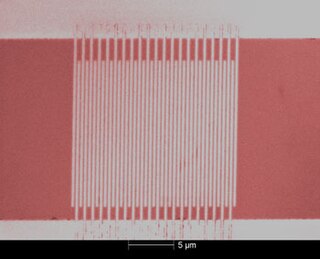
The superconducting nanowire single-photon detector is a type of optical and near-infrared single-photon detector based on a current-biased superconducting nanowire. It was first developed by scientists at Moscow State Pedagogical University and at the University of Rochester in 2001. The first fully operational prototype was demonstrated in 2005 by the National Institute of Standards and Technology (Boulder), and BBN Technologies as part of the DARPA Quantum Network.

Superfluid vacuum theory (SVT), sometimes known as the BEC vacuum theory, is an approach in theoretical physics and quantum mechanics where the fundamental physical vacuum is considered as a superfluid or as a Bose–Einstein condensate (BEC).
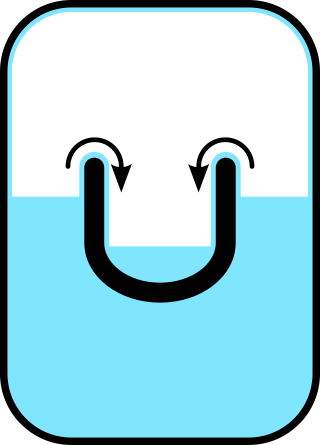
Superfluidity is the characteristic property of a fluid with zero viscosity which therefore flows without any loss of kinetic energy. When stirred, a superfluid forms vortices that continue to rotate indefinitely. Superfluidity occurs in two isotopes of helium when they are liquefied by cooling to cryogenic temperatures. It is also a property of various other exotic states of matter theorized to exist in astrophysics, high-energy physics, and theories of quantum gravity. The theory of superfluidity was developed by Soviet theoretical physicists Lev Landau and Isaak Khalatnikov.

Nicolas Gisin is a Swiss physicist and professor at the University of Geneva, working on the foundations of quantum mechanics, quantum information, and communication. His work includes both experimental and theoretical physics. He has contributed work in the fields of experimental quantum cryptography and long-distance quantum communication over standard telecom optical fibers. He also co-founded ID Quantique, a company that provides quantum-based technologies.
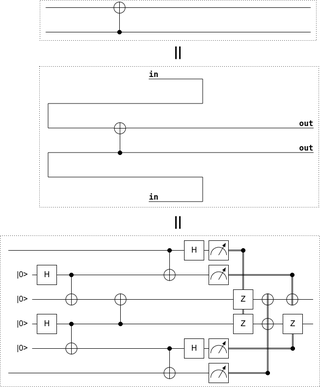
Quantum gate teleportation is a quantum circuit construction where a gate is applied to target qubits by first applying the gate to an entangled state and then teleporting the target qubits through that entangled state.
References
- ↑ Hotta, Masahiro (2008). "A protocol for quantum energy distribution". Physics Letters A. 372 (35): 5671. arXiv: 0803.1512 . Bibcode:2008PhLA..372.5671H. doi:10.1016/j.physleta.2008.07.007.
- ↑ Ikeda, Kazuki (2023). "Demonstration of Quantum Energy Teleportation on Superconducting Quantum Hardware". Physical Review Applied. 20 (2): 024051. arXiv: 2301.02666 . Bibcode:2023PhRvP..20b4051I. doi:10.1103/PhysRevApplied.20.024051.
- ↑ "First Demonstration of Energy Teleportation". Discover magazine. January 16, 2023.
- ↑ Wood, Charlie (February 23, 2023). "Physicists Use Quantum Mechanics to Pull Energy out of Nothing". Quanta magazine.
- ↑ "Scientists Defy Physics, Basically Pull Energy Out of Thin Air". Popular Mechanics. February 24, 2023.